七年级英语之-- 方位介词
- 格式:doc
- 大小:456.50 KB
- 文档页数:3
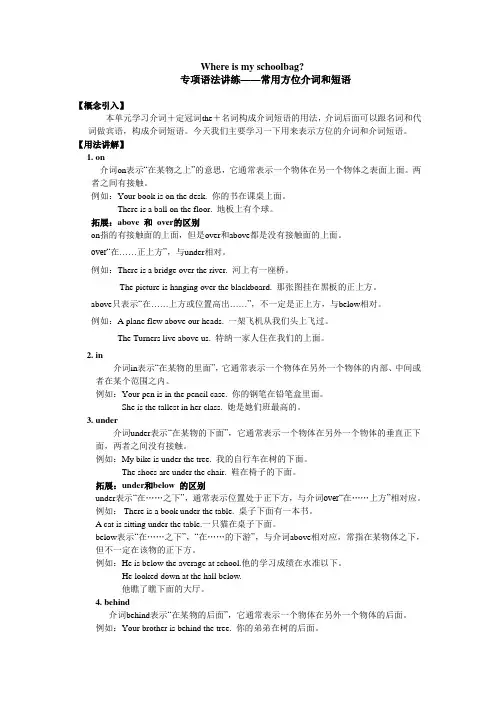
Where is my schoolbag?专项语法讲练——常用方位介词和短语【概念引入】本单元学习介词+定冠词the+名词构成介词短语的用法,介词后面可以跟名词和代词做宾语,构成介词短语。
今天我们主要学习一下用来表示方位的介词和介词短语。
【用法讲解】1. on介词on表示“在某物之上”的意思,它通常表示一个物体在另一个物体之表面上面。
两者之间有接触。
例如:Your book is on the desk. 你的书在课桌上面。
There is a ball on the floor. 地板上有个球。
拓展:above 和over的区别on指的有接触面的上面,但是over和above都是没有接触面的上面。
over“在……正上方”,与under相对。
例如:There is a bridge over the river. 河上有一座桥。
The picture is hanging over the blackboard. 那张图挂在黑板的正上方。
above只表示“在……上方或位置高出……”,不一定是正上方,与below相对。
例如:A plane flew above our heads. 一架飞机从我们头上飞过。
The Turners live above us. 特纳一家人住在我们的上面。
2. in介词in表示“在某物的里面”,它通常表示一个物体在另外一个物体的内部、中间或者在某个范围之内。
例如:Your pen is in the pencil case. 你的钢笔在铅笔盒里面。
She is the tallest in her class. 她是她们班最高的。
3. under介词under表示“在某物的下面”,它通常表示一个物体在另外一个物体的垂直正下面,两者之间没有接触。
例如:My bike is under the tree. 我的自行车在树的下面。
The shoes are under the chair. 鞋在椅子的下面。

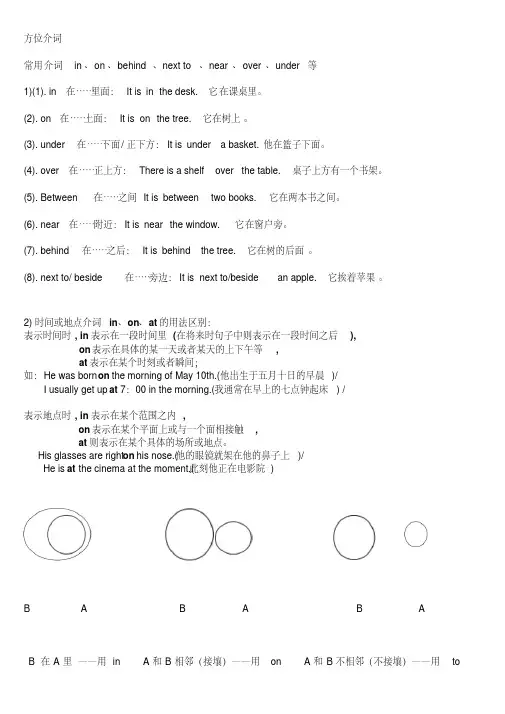
方位介词常用介词in、on、behind、next to、near、over、under等1)(1). in在……里面:It is in the desk.它在课桌里。
(2). on在……上面:It is on the tree.它在树上。
(3). under在……下面/正下方:It is under a basket.他在篮子下面。
(4). over在……正上方:There is a shelf over the table.桌子上方有一个书架。
(5). Between 在……之间It is between two books. 它在两本书之间。
(6). near在……附近:It is near the window. 它在窗户旁。
(7). behind在……之后:It is behind the tree. 它在树的后面。
(8). next to/ beside在……旁边:It is next to/beside an apple. 它挨着苹果。
2)时间或地点介词in、on、at的用法区别:表示时间时, in表示在一段时间里(在将来时句子中则表示在一段时间之后),on表示在具体的某一天或者某天的上下午等,at表示在某个时刻或者瞬间;如:He was born on the morning of May 10th.(他出生于五月十日的早晨)/I usually get up at 7:00 in the morning.(我通常在早上的七点钟起床) /表示地点时, in表示在某个范围之内,on表示在某个平面上或与一个面相接触,at则表示在某个具体的场所或地点。
His glasses are right on his nose.(他的眼镜就架在他的鼻子上)/He is at the cinema at the moment.(此刻他正在电影院)B A B A B AB 在A里——用in A和B相邻(接壤)——用on A和B不相邻(不接壤)——用to。


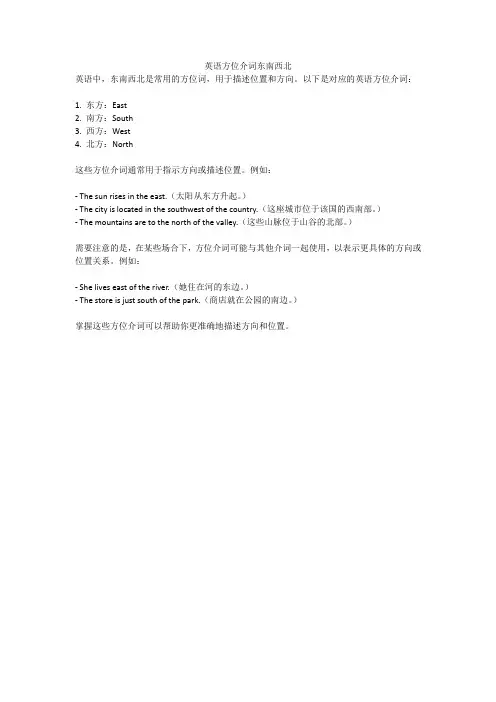
英语方位介词东南西北
英语中,东南西北是常用的方位词,用于描述位置和方向。
以下是对应的英语方位介词:
1. 东方:East
2. 南方:South
3. 西方:West
4. 北方:North
这些方位介词通常用于指示方向或描述位置。
例如:
- The sun rises in the east.(太阳从东方升起。
)
- The city is located in the southwest of the country.(这座城市位于该国的西南部。
)
- The mountains are to the north of the valley.(这些山脉位于山谷的北部。
)
需要注意的是,在某些场合下,方位介词可能与其他介词一起使用,以表示更具体的方向或位置关系。
例如:
- She lives east of the river.(她住在河的东边。
)
- The store is just south of the park.(商店就在公园的南边。
)
掌握这些方位介词可以帮助你更准确地描述方向和位置。
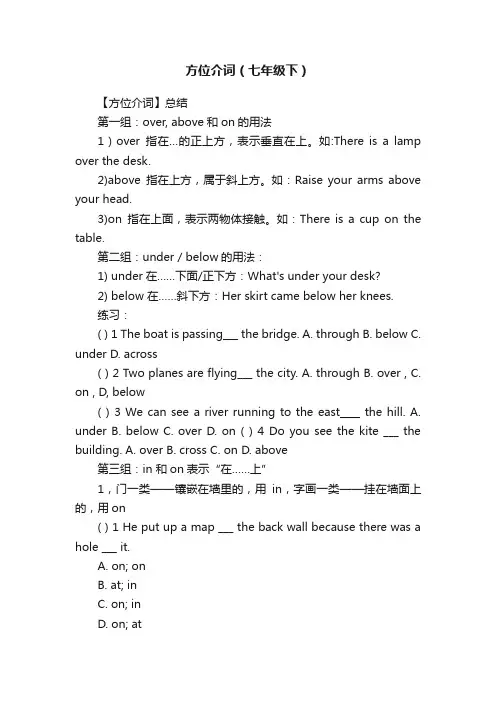
方位介词(七年级下)【方位介词】总结第一组:over, above和on的用法1)over指在…的正上方,表示垂直在上。
如:There is a lamp over the desk.2)above指在上方,属于斜上方。
如:Raise your arms above your head.3)on指在上面,表示两物体接触。
如:There is a cup on the table.第二组:under / below的用法:1) under在……下面/正下方:What's under your desk?2) below 在……斜下方:Her skirt came below her knees.练习:( ) 1 The boat is passing___ the bridge. A. through B. below C. under D. across( ) 2 Two planes are flying___ the city. A. through B. over , C. on , D, below( ) 3 We can see a river running to the east____ the hill. A. under B. below C. over D. on ( ) 4 Do you see the kite ___ the building. A. over B. cross C. on D. above第三组:in 和on表示“在……上”1,门一类——镶嵌在墙里的,用in,字画一类——挂在墙面上的,用on( ) 1 He put up a map ___ the back wall because there was a hole ___ it.A. on; onB. at; inC. on; inD. on; at( ) 2 There is a door___ the wall. A. on B. to C. of D.in( ) 3 Any man ___ eyes______ his head can see that he's exactly like a rope.A. with; onB. with; inC. on; withD. in; with2,鸟一类落在树上的,用in;苹果一类长在树上的,用on( ) 1 There are some birds singing___ the trees. A. in B. on C. at D. from ( ) 2 There are so many apples___ that tree. A. in B, on C. at D. from第四组:in /on/ to表示“接壤”( ) 1 The United States is ____ the south of Canada and ___ the east of Japan.A. to; inB. on; toC. in; besideD. at; on( ) 2 The man stood____the window, watching the boys playing outside.A. inB. byC. withD. to( ) 3 Japan lies____ the east of China.A. on B/ to C. in D. with第五组:at, in表示“在……”1)at表示较小的地点。
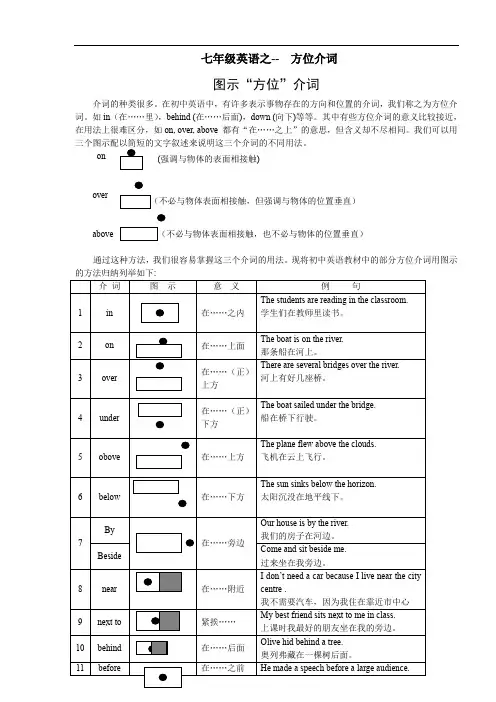
七年级英语之-- 方位介词图示“方位”介词介词的种类很多。
在初中英语中,有许多表示事物存在的方向和位置的介词,我们称之为方位介词。
如in(在……里),behind (在……后面),down (向下)等等。
其中有些方位介词的意义比较接近,在用法上很难区分,如on, over, above 都有“在……之上”的意思,但含义却不尽相同。
我们可以用三个图示配以简短的文字叙述来说明这三个介词的不同用法。
on overabove通过这种方法,我们很容易掌握这三个介词的用法。
现将初中英语教材中的部分方位介词用图示(强调与物体的表面相接触)资料赠送以下资料考试知识点技巧大全一、考试中途应饮葡萄糖水大脑是记忆的场所,脑中有数亿个神经细胞在不停地进行着繁重的活动,大脑细胞活动需要大量能量。
科学研究证实,虽然大脑的重量只占人体重量的2%-3%,但大脑消耗的能量却占食物所产生的总能量的20%,它的能量来源靠葡萄糖氧化过程产生。
据医学文献记载,一个健康的青少年学生30分钟用脑,血糖浓度在120毫克/100毫升,大脑反应快,记忆力强;90分钟用脑,血糖浓度降至80毫克/100毫升,大脑功能尚正常;连续120分钟用脑,血糖浓度降至60毫克/100毫升,大脑反应迟钝,思维能力较差。
我们中考、高考每一科考试时间都在2小时或2小时以上且用脑强度大,这样可引起低血糖并造成大脑疲劳,从而影响大脑的正常发挥,对考试成绩产生重大影响。
因此建议考生,在用脑60分钟时,开始补饮25%浓度的葡萄糖水100毫升左右,为一个高效果的考试加油。
二、考场记忆“短路”怎么办呢?对于考生来说,掌握有效的应试技巧比再做题突击更为有效。
1.草稿纸也要逐题顺序写草稿要整洁,草稿纸使用要便于检查。
不要在一大张纸上乱写乱画,东写一些,西写一些。
打草稿也要像解题一样,一题一题顺着序号往下写。
最好在草稿纸题号前注上符号,以确定检查侧重点。
为了便于做完试卷后的复查,草稿纸一般可以折成4-8块的小方格,标注题号以便核查,保留清晰的分析和计算过程。

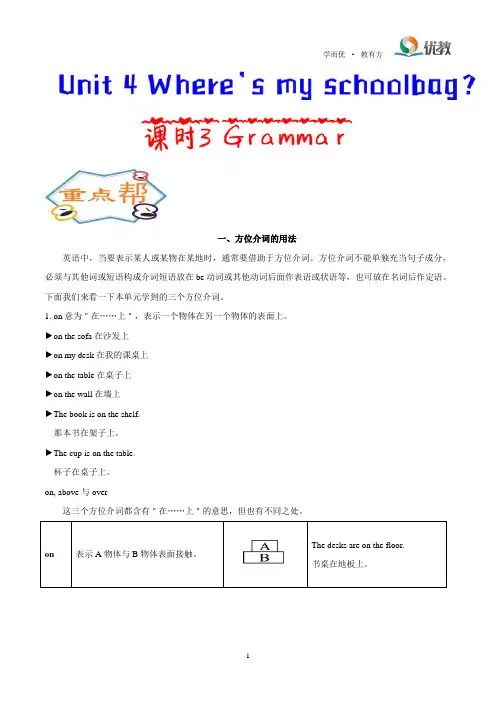
一、方位介词的用法英语中,当要表示某人或某物在某地时,通常要借助于方位介词。
方位介词不能单独充当句子成分,必须与其他词或短语构成介词短语放在be动词或其他动词后面作表语或状语等,也可放在名词后作定语。
下面我们来看一下本单元学到的三个方位介词。
1. on意为"在……上",表示一个物体在另一个物体的表面上。
►on the sofa在沙发上►on my desk在我的课桌上►on the table在桌子上►on the wall在墙上►The book is on the shelf.那本书在架子上。
►The cup is on the table.杯子在桌子上。
on, above与over这三个方位介词都含有"在……上"的意思,但也有不同之处。
The desks are on the floor.on 表示A物体与B物体表面接触。
书桌在地板上。
above表示A物体位置高于B物体,但不一定在其正上方,也不接触B物体。
He lifted his hands above his head. 他将双手举过头顶。
over表示A物体在B物体的垂直正上方,多暗指悬空。
The kite is right over the house. 风筝在房子的上方。
2. in意为"在……里面",指的是一个物体在另一个物体的内部。
►in the room 在房间里►in the box 在盒子里►in her backpack 在她的背包里►The dictionary is in the schoolbag.字典在书包里。
►My pen is in the pencil box.我的钢笔在铅笔盒里。
(1)be in 在家,相当于be at home,常用于打电话。
►—Hello. This is Mary. Is Lucy in?您好,我是玛丽,露西在家吗?—Sorry, she’s at school.对不起,她在学校。
(2)in+颜色/衣物,表示"穿着;戴着"。
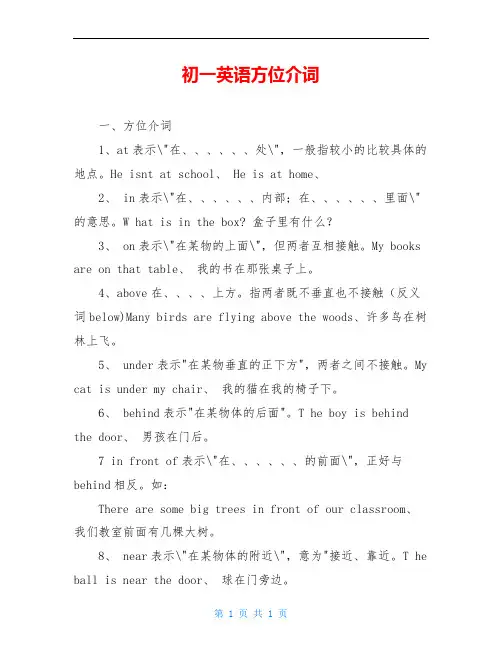
初一英语方位介词一、方位介词1、at表示\"在、、、、、、处\",一般指较小的比较具体的地点。
He isnt at school、 He is at home、2、 in表示\"在、、、、、、内部;在、、、、、、里面\"的意思。
W hat is in the box? 盒子里有什么?3、 on表示\"在某物的上面\",但两者互相接触。
My books are on that table、我的书在那张桌子上。
4、above在、、、、上方。
指两者既不垂直也不接触(反义词below)Many birds are flying above the woods、许多鸟在树林上飞。
5、 under表示"在某物垂直的正下方",两者之间不接触。
My cat is under my chair、我的猫在我的椅子下。
6、 behind表示"在某物体的后面"。
T he boy is behind the door、男孩在门后。
7 in front of表示\"在、、、、、、的前面\",正好与behind相反。
如:There are some big trees in front of our classroom、我们教室前面有几棵大树。
8、 near表示\"在某物体的附近\",意为"接近、靠近。
T he ball is near the door、球在门旁边。
介词in, on, under, behind是表示静态位置的介词。
二、常见方位介词短语(一)、由介词in构成的方位介词短语1、in the front 在前面2、in the front row 在前排3、in the back row 在后排4、in the third row 在第三排5、in front of、、、在、、、前面(范围之外)6、in the front of、、、在、、、前部(范围之内)7、in the middle在中间8、in the street在街上9、in the middle of、、、在中间10、in the tree在树上(指飞鸟等外来物)(二)、由介词at构成的方位介词短语1、at the front of、、、在、、、所在范围的前一部分2、at the back of、、、在、、、所在范围的后一部分3、at the foot of、、、在、、、脚下4、at the top of、、、在、、、顶部5、at the end of、、、在、、、尽头6、at the head of、、、在、、、前头7、at the(school)gate在(校)门口8、at the station 在车站9、at No、2 Chang’an Road在长安路2号10、at my uncle’s 在我叔叔家11、at home在家12、at the doctor’s在医务室/在诊所(三)、由介词on构成的方位介词短语1、on the right/left在右(左)边2、on one’s right/left在某人的右(左)边3、on the desk/table在课桌/桌上4、on the right-hand/left-hand side在右/左手边5、on the blackboard在黑板上6、on/in the wall在墙上/里7、on the paper在纸上8、on the tree在树上(指树上长的,结的东西)三、其它介词构成的方位介词短语1、next to靠近/贴近2、beside the desk在课桌旁3、behind the door在门后4、under the bed在床下5、near the window靠近窗户6、outside the gate在门外。
初中英语语法总结:方位介词(有答案)A。
XXX初中英语语法总结:方位介词方位介词用于描述物体或人在空间中的位置关系,常见的有in、on、behind、next to、near、over、under等。
1.in表示在某个物体内部,如XXX可以改为XXX XXX XXX.2.on表示在某个物体的表面,如There are some apples on the tree.可以改为The apples are on the surface of the tree.3.under表示在某个物体的下面或正下方,如What's under your desk?可以改为XXX?4.over表示在某个物体的正上方,如There is a shelf over the table.可以改为There is a shelf above the table.5.XXX表示在某个物体的斜上方,如Raise your arms above your head.可以改为Lift your arms at an angle above your head.6.below表示在某个物体的斜下方,如XXX可以改为XXX.7.XXX表示在某个物体的后面,如There XXX.可以改为There is a bike at the back of the tree.8.XXX表示在某个物体的旁边,如There is a café next to the barber's.可以改为There is a café beside the barber's.9.near表示在某个物体的附近,如My bed is near the window.可以改为My bed is close to the window.XXX表示在某个物体的旁边,如He was XXX.可以改为He was sitting next to the window.练:1.XXX passing ___ the bridge.A。
初中英语重难点之“方位”介词介词的种类很多。
在初中英语中,有许多表示事物存在的方向和位置的介词,我们称之为方位介词。
如in(在……里),behind (在……后面),down (向下)等等。
其中有些方位介词的意义比较接近,在用法上很难区分,如on, over, above 都有“在……之上”的意思,但含义却不尽相同。
我们可以用三个图示配以简短的文字叙述来说明这三个介词的不同用法。
on(强调与物体的表面相接触)通过这种方法,我们很容易掌握这三个介词的用法。
现将初中英语教材中的部分方位介词用图示的方法归纳列举如下:几组方位介词的区别方位介词in, on, to的区别:1.in表示"在……范围内”,还表示“在…之中”Chongqing lies in the southwest of China.2.on表示“与……毗邻,接壤”Canada lies on the north of America.3.to表示方位,不接壤Hunan lies to the east of Zhejiang.表示地点位置的介词:1.at, in, on, toat 用于小地方,at school, at homeIn 用于大地方,in Beijing, in ChinaOn在……上面,on the map, on the table To到……To Chongqing2.Above, over, onAbove在……上方(高过另一个物体,不强调垂直)The airplane flies above that tall building.(不在正上方)over在……上方(垂直上方)The bridge spans over the river.On在……上面(物体表面有接触)There's some water on the floor, so you should be careful.3.Below, under在……下面Under在……下(正下方)The cat lies under the chair.(正下方)Below在……下(不一定是正下方)The cat lies under the chair.(不是正下方)4.in front of, in the front of 在……的前面in front of 在外部的前面,两个东西是独立的,相反的是behindThe building is in front of the hospital.The building is behind the hospital.In the front of在内部的前面,属于其中的一部分,相反的是at the back of The girl stands in the front of the classroom.The girl stands at the back of the classroom.5.Beside, near, byBeside在旁边Near在附近By在附近,非常靠近常见方位介词短语(一)、由介词in构成的方位介词短语1、in the front 在前面2、in the front row 在前排3、in the back row 在后排4、in the third row 在第三排5、in front of... 在...前面(范围之外)6、in the front of... 在...前部(范围之内)7、in the middle在中间8、in the street在街上9、in the middle of...在中间10、in the tree在树上(指飞鸟等外来物)(二)、由介词at构成的方位介词短语1、at the front of...在...所在范围的前一部分2、at the back of...在...所在范围的后一部分3、at the foot of...在...脚下4、at the top of...在...顶部5、at the end of...在...尽头6、at the head of...在...前头7、at the(school)gate在(校)门口8、at the station 在车站9、at No.2 Chang’an Road在长安路2号10、at my uncle’s 在我叔叔家11、at home在家12、at the doctor’s在医务室/在诊所(三)、由介词on构成的方位介词短语1、on the right/left在右(左)边2、on one’s right/left在某人的右(左)边3、on the desk/table在课桌/桌上4、on the right-hand/left-hand side在右/左手边5、on the blackboard在黑板上6、on/in the wall在墙上/里7、on the paper在纸上8、on the tree在树上(指树上长的,结的东西)三、其它介词构成的方位介词短语1、next to靠近/贴近2、beside the desk在课桌旁3、behind the door 在门后4、under the bed在床下5、near the window靠近窗户6、outside the gate 在门外。
七年级下册方位介词知识点方位介词是英语中用来描述物体在空间中的位置关系的一种词汇。
在日常生活中,方位介词经常被使用,并且在英语学习中也是非常重要的一部分。
在七年级下册中,掌握方位介词的知识点,将有助于学生更好地理解这一部分内容。
下面将介绍一些七年级下册方位介词的知识点。
1. 在/在…的上面“On”是一个表示物体在另一个物体上方的方位介词,例如:- The picture is on the wall.(图片在墙上。
)- The cat is on the chair.(猫在椅子上。
)其中,“on”也可以用来表示时间上在某个具体日子或在某个时候:- We’ll have the meeting on Tuesday.(我们将在星期二开会。
)2. 在/在…的下面“Under”是一个表示物体在另一个物体下方的方位介词,例如:- The cat is under the table.(猫在桌子下面。
)- The book is under the bed.(书在床下。
)3. 在/在…的前面“in front of”是一个表示一物体在另一个物体前面的方位介词,例如:- The teacher is standing in front of the class.(老师站在课堂前面。
)- The car parked in front of the house.(汽车停在房子前面。
)其中,“in front of”有时也可以被缩写为“in front”或者“front”。
4. 在/在…的后面“behind”是一个表示一个物体在另一个物体后面的方位介词,例如:- The cat is behind the sofa.(猫在沙发后面。
)- The car parked behind the building.(汽车停在建筑物后面。
)5. 在…中间“between”是一个表示两个物体之间的方位介词,例如:- There is a book between the two bottles.(两个瓶子之间有一本书。
语法总结:方位介词表示地点的介词in、on、behind、next to、near、over、under(1). in在……里面:The pencil is in the desk. 铅笔在课桌里。
(2). on在……上面:There are some apple on the tree. 树上有些苹果。
(3). under在……下面/正下方:What's under your desk? 你书桌底下是什么?(4). over在……正上方:There is a shelf over the table. 桌子上方有一个书架。
(5). above 在……斜上方:Raise your arms above your head.(6). below 在……斜下方:Her skirt came below her knees.(7).behind在……之后:There is a bike behind the tree. 树后有一辆自行车。
(8).next to在……旁边:There is a café next to the barber's. 理发店隔壁是一家咖啡馆。
(9).near在……附近:My bed is near the window. 我的床在窗户旁。
(10).by 在……旁:He was sitting by the window.第一组:over, above和on的用法1)over指在…的正上方,表示垂直在上。
如:There is a lamp over the desk.2)above指在上方,属于斜上方。
如:Raise your arms above your head.3)on指在上面,表示两物体接触。
如:There is a cup on the table.第二组:under / below的用法:1) under在……下面/正下方:What's under your desk?2) below 在……斜下方:Her skirt came below her knees.练习:( ) 1 The boat is passing___ the bridge.A. throughB. belowC. underD. across( ) 2 Two planes are flying___ the city.A. throughB. overC. on D, below( ) 3 We can see a river running to the east____ the hill.A. underB. belowC. overD. on( ) 4 Do you see the kite ___ the building.A. overB. crossC. onD. above参考答案C B B D第三组:in 和on表示“在……上”门一类——镶嵌在墙里的,用in字画一类——挂在墙面上的,用on( ) 1 He put up a map ___ the back wall because there was a hole ___ it. A. on; on B. at; in C. on; in D. on; at( ) 2 There is a door___ the wall.A. onB. toC. ofD. in( ) 3 Any man ___ eyes______ his head can see that he's exactly like a rope.A. with; onB. with; inC. on; withD. in; with鸟一类落在树上的,用in;苹果一类长在树上的,用on( ) 1 There are some birds singing___ the trees.A. inB. onC. atD. from( ) 2 There are so many apples___ that tree.A. in B, on C. at D. from第四组:in /on/ to表示“接壤”第四组:in /on/ to表示“接壤”B A B AB 在A里——用in A和B相邻(接壤)——用on。
七年级语法常用方位介词和短语↑常用方位介词和短语1概念引入本单元学习介词+定冠词the+名词构成介词短语的用法,介词后面可以跟名词和代词做宾语,构成介词短语。
今天我们主要学习一下用来表示方位的介词和介词短语。
2用法讲解1. on介词on表示“在某物之上”的意思,它通常表示一个物体在另一个物体之表面上面。
两者之间有接触。
例如:Your book is on the desk. 你的书在课桌上面。
There is a ball on the floor. 地板上有个球。
拓展:above 和 over的区别on指的有接触面的上面,但是over和above都是没有接触面的上面。
over“在……正上方”,与under相对。
例如:There is a bridge over the river. 河上有一座桥。
The picture is hanging over the blackboard.那张图挂在黑板的正上方。
above只表示“在……上方或位置高出……”,不一定是正上方,与below相对。
例如:A plane flew above our heads. 一架飞机从我们头上飞过。
The Turners live above us. 特纳一家人住在我们的上面。
2. in介词in表示“在某物的里面”,它通常表示一个物体在另外一个物体的内部、中间或者在某个范围之内。
例如:Your pen is in the pencil case. 你的钢笔在铅笔盒里面。
She is the tallest in her class. 她是她们班最高的。
3. under介词under表示“在某物的下面”,它通常表示一个物体在另外一个物体的垂直正下面,两者之间没有接触。
例如:My bike is under the tree. 我的自行车在树的下面。
The shoes are under the chair. 鞋在椅子的下面。
初一英语方位介词区分英文English: In English, prepositions of place are essential for indicating the location of objects or people in relation to other objects or places. The prepositions "in," "on," and "at" are commonly used to describe different spatial relationships. "In" is used to denote being inside an enclosed space or a general location, such as "in the house" or "in the city." "On" typically indicates being in contact with a surface or located at a higher level, such as "on the table" or "on the roof." "At" is used to specify a particular point or location, often with a sense of direction, like "at the corner" or "at the bus stop." Understanding the appropriate usage of these prepositions is crucial for accurately describing positions and locations in English.中文翻译:在英语中,方位介词对于表达物体或人与其他物体或地点的位置关系至关重要。
七年级英语之-- 方位介词
图示“方位”介词
介词的种类很多。
在初中英语中,有许多表示事物存在的方向和位置的介词,我们称之为方位介词。
如in(在……里),behind (在……后面),down (向下)等等。
其中有些方位介词的意义比较接近,在用法上很难区分,如on, over, above 都有“在……之上”的意思,但含义却不尽相同。
我们可以用三个图示配以简短的文字叙述来说明这三个介词的不同用法。
on over
above
通过这种方法,我们很容易掌握这三个介词的用法。
现将初中英语教材中的部分方位介词用图示
(强调与物体的表面相接触)
他在许多观众面前发表了讲话。
12 outside 在……外面He parked his car outside the heater. 他把汽车停在剧场外面。
13 to 到……去We walked to the fruit shop. 我们步行到水果店。
14 from
从……来
We traveled to London from Edingburgh.
我们从爱丁堡旅行到伦敦。
15 (a)round 围绕……All sat around the table.
所有的人围绕着桌子坐。
16 between 在……之间
(指二者)
The letter B is between A and C.
字母B在A和C之间。
17 among 在……之间
(指三者或
三者以上)
The house stands among the trees.
房子在树丛中。
18 across 横过、越
过……
If the road is busy, don’t walk across it.
如果道路拥挤,就不要横穿马路。
19 through 穿过……We drove the tunnel.
我们开车穿过了隧道。
20 onto 向上The men lift the baskets onto the trucks. 人们把篮子运上卡车。
21 into 从……出来They put the apples into the baskets. 他们把苹果放进篮子里。
22 out of Don’t look out of the window in class. 上课时不要朝窗外看。
23 along 沿着Walk along this street, then turn left, you can see the post office.
沿着这条街走,然后向右拐,你就可以看到邮局。
24 up
向上
The monkeys climbed up the trees to pick the
bananas.
猴子爬上树上去摘香蕉。
25 down 向下The ball is rolling down the hill. 球正往山下滚。